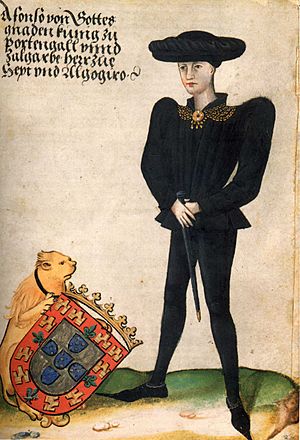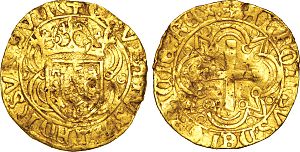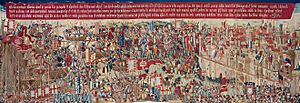Afonso V of Portugal facts for kids
Quick facts for kids Afonso V |
|
|---|---|

Contemporary portrait in the Itinerarium of Georg von Ehingen, c. 1470
|
|
| King of Portugal | |
| Reign | 13 September 1438 – 11 November 1477 |
| Acclamation | 15 January 1446 |
| Predecessor | Edward |
| Successor | John II |
| Reign | 15 November 1477 – 28 August 1481 |
| Predecessor | John II |
| Successor | John II |
| Regents |
See list
|
| Born | 15 January 1432 Sintra Palace, Portugal |
| Died | 28 August 1481 (aged 49) Lisbon, Portugal |
| Burial | Batalha Monastery |
| Spouse | |
| Issue |
|
| House | Aviz |
| Father | Edward, King of Portugal |
| Mother | Eleanor of Aragon |
| Signature | |
Afonso V (born January 15, 1432 – died August 28, 1481) was a king of Portugal. He ruled from 1438 until his death in 1481, with a short break in 1477. He was known as "the African" because of his military victories in North Africa.
By 1471, Afonso V was the first king of Portugal to claim power over a group of territories called the "Kingdom of the Algarves." Before him, it was just called the "Kingdom of the Algarve." The new lands added to Portugal in North Africa were seen as part of the "Algarves." This meant the southern Portuguese lands on both sides of the Strait of Gibraltar.
Contents
Becoming King: Afonso V's Early Life
Afonso was born in Sintra, Portugal. He was the second son of King Edward of Portugal and Queen Eleanor of Aragon. When his older brother, Infante João, passed away, Afonso became the heir to the throne. His father made him the first Prince of Portugal. This was a special title for the king's oldest son, similar to what they did in England. Afonso was only six years old when his father died in 1438, and he became king.
A Young King and His Regents
Because Afonso was so young, his mother, Eleanor, was supposed to rule for him. This is called a regency. However, many people did not like her as regent because she was from another country and was a woman. In 1438, a special meeting of leaders (called the cortes) decided that Eleanor and Pedro, Duke of Coimbra, should rule together. Pedro was the late king's younger brother.
This shared rule did not work well. In 1439, the cortes chose Pedro to be the main ruler and protector of the king and the kingdom. Eleanor tried to fight this decision, but she did not have enough support in Portugal. She eventually left for Castile, a neighboring kingdom.
Pedro's Rule and Challenges
Pedro, the Duke of Coimbra, wanted to make the king's power stronger. He also wanted to limit the power of the rich noble families. Portugal did well under his rule, but it was not always peaceful. His new laws upset many powerful nobles.
The Count of Barcelos, who was Pedro's half-brother and enemy, became a favorite of the young King Afonso. He started a constant fight for power against Pedro. In 1442, the king made the count his uncle Afonso the first Duke of Braganza. This made him the most powerful and richest man in Portugal. To keep his power as regent, Pedro arranged for King Afonso to marry his daughter, Isabella of Coimbra, in 1445.
The End of the Regency
On June 9, 1448, King Afonso V became old enough to rule on his own. Pedro had to give up his power. The Duke of Braganza's plans against Pedro finally succeeded. On September 15 of that year, Afonso V canceled all the laws and rules made during Pedro's regency.
The next year, based on false accusations, Afonso declared Pedro a rebel. Their armies fought in the Battle of Alfarrobeira. Sadly, Pedro, who was Afonso's uncle and father-in-law, was killed in this battle.
Afonso V's Adventures in North Africa
After dealing with problems at home, Afonso V turned his attention to North Africa. His grandfather, John I of Portugal, had conquered Ceuta from the king of Morocco. Afonso V wanted to expand these conquests.
His army captured Alcácer Ceguer in 1458 and Arzila in 1471. The city of Tangiers was won and lost several times between 1460 and 1464. These victories earned King Afonso the nickname "the African" or "Africano".
The king also supported the exploration of the Atlantic Ocean. This work was led by Henry the Navigator. However, after Henry died in 1460, Afonso did not continue his efforts much. As a ruler, Afonso V was not very active in changing laws or growing trade. He preferred to keep things as they were, following the lead of his father and grandfather. In 1469, King Afonso V gave Fernão Gomes the special right to control trade in the Gulf of Guinea.
Papal Bulls and Their Impact
In 1452, Pope Nicholas V issued a special order called a papal bull named Dum Diversas. This order gave Afonso V the right to make "Saracens, pagans and any other unbelievers" into slaves. This was confirmed and expanded in another bull, Romanus Pontifex, in 1455. Some people later saw these papal orders as a reason for the start of the slave trade and European colonialism.
Conflicts with Castile

After his campaigns in Africa, Afonso V found new reasons to fight in the neighboring kingdom of Castile. On December 11, 1474, King Henry IV of Castile died. He had no sons, only a daughter named Joanna.
Henry's death started a War of the Castilian Succession. One group supported Joanna, and another supported Isabella I of Castile, Henry's half-sister. Afonso V was convinced to help Joanna, who was his niece. He promised to marry her and declared himself king of Castile. He then led his troops into Castile. Because they were closely related, they needed special permission from the Pope to marry.
The Battle of Toro
On May 12, 1475, Afonso entered Castile with a large army. In March 1476, after many small fights, Afonso's army faced a Castilian force of similar size in the Battle of Toro. The Castilians were led by Isabella's husband, Prince Ferdinand II of Aragon.
The battle was fierce and confusing. The result was a draw, meaning neither side clearly won. While some of Afonso's forces were defeated, his son, Prince João, led his troops to victory over part of the Castilian army. Both sides claimed victory. However, Afonso's chances of becoming king of Castile were greatly hurt.
Later Years and Abdication
After the battle, Afonso sailed to France. He hoped to get help from King Louis XI in his fight against Castile. But he felt tricked by the French king and returned to Portugal in 1477.
Feeling disappointed, he gave up his throne for a few days in November 1477. He gave it to his son, John II. Afonso then returned to the throne, but later retired to a monastery in Sintra. He passed away there in 1481.
Afonso V's Family
Afonso V married twice. His first marriage was in 1447 to Isabella of Coimbra. They had three children:
- John, Prince of Portugal (born January 29, 1451).
- Joan, Princess of Portugal (born February 6, 1452 – died May 12, 1490): She is known as Saint Joan of Portugal.
- John II of Portugal (born March 3, 1455 – died October 25, 1495): He became the 13th King of Portugal after his father.
Afonso's second marriage was in 1475 to his niece, Joanna of Castile. She was known as "La Beltraneja."
Images for kids
See also
 In Spanish: Alfonso V de Portugal para niños
In Spanish: Alfonso V de Portugal para niños



